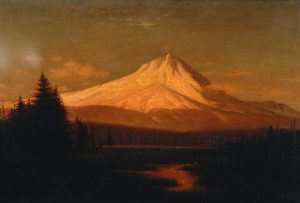19th Century Landscapes from the
New Bedford Free Public Library’s Collection

Curated by Allie Copeland
8/15 – 12/31/2020
Artists who created landscapes that sought to evoke feelings of awe, fear, or exaltation were said to be depicting the Sublime. These artists often enhanced the grandeur of their landscapes with dramatic contrast in lighting and exaggeration of certain natural features, like the height of a cliff, in order to recreate the feeling of that scene inside the safety of their studio.
New Bedford Free Public Library Presents
CITY GALLERY AND READING ROOM
Since 1852, the library has amassed extensive holdings of printed works, manuscripts, graphics, fine art, and objects used for research, exhibit, and educational purposes.
The art collection is on public view at the Main Library, and special exhibitions, curated by Allie Copeland, are showcased in the City Gallery at the New Bedford Art Museum.
Coming soon!
Bradford, William. Mount Hood. NBFPL, 1961.
Pastoral Light
19th Century Landscapes from the New Bedford Free Public Library’s Collection
Curated by Allie Copeland
On View at NBAM 8/15 – 12/31/2020
This exhibition is produced in conjunction with
In the 19th century, landscapes had become increasingly popular subjects for American artists, as the first industrial revolution meant more families living in urban centers looking for vicarious experiences in their art. This interest gave rise to “artist adventurers” like William Bradford, and allowed for the development of new movements in American art, like the Hudson River School painters.
Artists who created landscapes that sought to evoke feelings of awe, fear, or exaltation were said to be depicting the Sublime. These artists often enhanced the grandeur of their landscapes with dramatic contrast in lighting and exaggeration of certain natural features, like the height of a cliff, in order to recreate the feeling of that scene inside the safety of their studio. The subject of these paintings was then not just the landscape itself, but also the feeling it conjured.
On the other hand, many 19th century artists still created landscapes that were inspired by European pastoral and picturesque ideals rather than the new epic romanticism of the era. These artists produced calmer, simpler scenes of rural landscapes, sometimes entirely invented, and often with an element of human presence that reinforced man’s dominion over nature, like Joseph Van Luppen’s cowherd in the Alps. A pastoral or picturesque landscape might evoke feelings of calm, comfort, or harmony and encourage the viewer to leisurely reflect on the vista depicted.